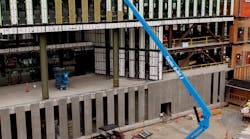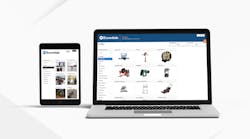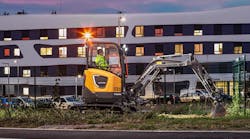Doosan Bobcat, Point of Rental, Reachmaster Take Top Prizes in RER's Innovative Product Awards
Mobile phones are now universal and ubiquitous. According to Global Systems for Mobile Communications, more than 5 billion people, about two-thirds of the world’s population, now have a mobile phone connection. But – at least to the best of our knowledge – only one company has created an app whereby earthmoving construction equipment can be operated via remote control on a cellular phone device, and that is Doosan Bobcat’s new MAXControl iOS Remote Control for Bobcat Loaders. Because of that, and the fact that the iPhone- or iPad-based remote-control system can be used on Bobcat loaders manufactured as long ago as 2004, the Innovative Product Award judges for 2019 overwhelmingly voted it the Gold Award prize winner.
Technology was also a major factor in the selection of the Silver Award – Point of Rental Software’s POR One – an app that unifies all of the company’s app offerings into a fully connected mobile interface for its users.
Point of Rental, a perennial favorite with IPA judges, narrowly edged another repeat winner, mobile elevating work platform supplier Reachmaster, winner of the Gold Award in 2015 for the Bibilift 26-BL track-mounted scissorlift. This year Reachmaster is back with the similarly named Jibbi 40BL- EVO, a compact all-terrain boomlift on tracks with bi-lateral levelling that allows for it to keep the operator level while traversing on sloped areas and allowing it to move into close proximity to working areas.
It was another impressive year of innovation, including the other category winners and a few dozen more that raised the bar on what is possible for rental equipment. Other
winners of their categories that scored votes for the grand prizes included Doosan Portable Power, which took home two category awards: Compressors/Air Tools for its XP185WDO air compressor, and Generators/Welders for its Intelligent Load Management System. Kubota Tractor Corp. won the Earthmoving category for its SVL65-2 compact track loader; Briggs & Stratton’s Vanguard took home the Engines/Power Sourcing category for the Vanguard Commercial Lithium-Ion Battery; and Toro won the Lawn & Garden category for its TRX-250 walk-behind trencher. Co-winner of the Lifts category with Reachmaster’s Jibbi was Hy-Brid Lift’s ZT-1630 scissor lift, which tallied well in the overall voting. The light tower category was taken by Canada’s Lind Equipment for its All-in-One Beacon LED Tower.
Reachmaster also was a double-category winner, taking home Material Handling for its Lassius 2200 by Winlet, a battery-operated small pick-and-carry crane, as well as in the Lifts category for the Jibbi. The Miscellaneous category was taken by Ledwell for its solar-powered lift loading ramp. The Pumps category was won by Xylem for its Godwin CD1505 Dri Prime Pump.
Gold winner Doosan Bobcat won in the Technology Enhancements category, and the Computer Software category was taken by Point of Rental.
We’ll be profiling all the category winners as well as the Honorable Mentions in the months to come. But this month we’ll concentrate on the Gold, Silver and Bronze Award winners. Read on!
@@@@@@@@@@@@@@@@@@@@@@@@@@@@@@@@@@@@@@@@
Doosan Bobcat
Gold Award
MAXControl iOS Remote Control for Bobcat Loaders
Key Innovation: Doosan Bobcat has created an application with related machine controls, and simple hardware to enable the first piece of construction equipment that can be controlled remotely using a common iOS device such as an iPhone or iPad.
It started almost by accident. In late 2018, Doosan Bobcat had invited some customers to its acceleration center in Bismarck, N.D., and were talking with them and showing them some research on autonomous machines.
“We were demonstrating this basic remote control, it was a rudimentary version we had on an iPhone that demonstrates some of this capability,” recalls Joel Honeyman, vice president of global innovation for Doosan Bobcat. “And a number of customers commented, ‘Can I just get that remote control?’ And we said, ‘What, you want just the app?’ And they said ‘Yeah!’ So, we asked why, and they said, ‘I don’t want to get in and out of the machine anymore. When I have to do some simple little jobs around the jobsite, I just want a simple remote control, and if I can do it on a phone, that would be great, because I always have my phone in my pocket.’ So that’s where the idea was born.”
The company started to advance the project in early 2019, refined it and began a limited launch later in the year.
“I’d call it somewhat of an accidental innovation,” says Honeyman. “It wasn’t really our goal when we showed it. We were thinking about more advanced autonomous solutions, which we are working on, but this became a piece that customers had an interest in.’”
Here is Doosan Bobcat’s product description: “There is no other piece of construction equipment in the world that can be this easily retrofitted for a common iOS device such a phone or tablet to enable remote control functionality. The control box (hardware) can be plugged into any Bobcat-branded loader equipped with selectable joystick controls all the way back to 2004. This means we can apply today's latest technology to a piece of equipment manufactured as much as 15 years ago. With an installation time of less than 10 minutes of a simple piece of hardware and an iOS app, an equipment operator can create a modern, remote controlled piece of construction equipment up to 100 yards away. The app is simple but powerful in usage. This allows the user to remotely control any function of the machine -- drive, lift and tilt of the work group, engine speed, and the use of any work attachment on the unit.
“It has built-in haptic feedback to indicate to the user when full stroke of the control has been achieved. Finally, we created ‘light’ and ‘dark’ background coloring so an operator can adjust to see more clearly depending on daylight conditions. Unlike dedicated remote controls today which use an expensive, specialty device, we are simply using what every construction operator has today -- the phone in their pocket. Our first solution we are launching utilizes an iPhone or iPad, but Android devices will be compatible in 2020.”
Customer research showed the Bobcat staff there was strong interest in the technology to solve simple needs on jobsites.
“It’s the simple types of things like moving a machine 20 or 30 feet, or they need to position a machine while being outside of it,” says Honeyman. “The other application people are really excited about is trailering it, putting it on and off a trailer and being able to view the machine from the outside. Sometimes being in a machine getting on and off a trailer can be rather intimidating for people.
“We have another customer here in Fargo who is working in his excavator and doing trench work, and he uses the loader with a remote control while sitting in the excavator to backfill the trench as he’s going along. The small types of tasks where people say, ‘I just don’t want to take the time getting in and out of the machine.’ That was the real crux of what customers were telling us.”
RER’s panel of judges were also impressed with the app being retrofittable to units as old as 2004 as long as the Bobcat loader has selectable joystick controls.
“We really like that you can add a new piece of technology to an older piece of equipment in the field,” Honeyman adds.
The MAXControl is a dynamic app, and Bobcat will be adding new features this year, such as an optional game controller, basically an xBox controller. The company is also developing a front-view camera where users can see out of the front of the machine from the app that works particularly effectively with an iPad because of its larger size.
Bobcat is continually looking at ways to improve the app, with other features such as object avoidance where the user can designate objects to avoid and other features of semi-autonomous application.
The app is essentially a virtual set of joysticks. The designers built in haptic feedback so when the machine is getting too far away and starts sensing that it’s going to lose its signal, the phone will begin to vibrate and pulse to indicate to the user that the machine is getting out of range.
Honeyman adds that all the same functions a loader user will perform from within the machine can be done on the app. “You can do drive, lift, tilt, all your auxiliary hydraulic functions are on the app, as well as the engine throttle. You can control the engine speed, the speed of the machine, you can run a snowblower or a planer if you want to,” he says. “Everything you can do on the machine, you can do on the app.”
Promotional Video Link
@@@@@@@@@@@@@@@@@@@@@@@@@@@@@@@@@@@@@@@@@@@@@@@@@@@@@@@@@@@@@@@@@@@@@@@@@@@@@@@
Point of Rental Software
Silver Award
POR ONE
Key Innovation: Internal mobile communication capabilities with software integration.
Product Description: “Point of Rental has been setting the standard for mobile capabilities in rental software since implementing wireless alerts in 2011. From Rental Essentials (2014) to Inspection App (2017), the company has always been on the forefront of mobile-based rental.
“In 2019, the company built a new home to unify its app offerings and provide a fully connected mobile interface for its users. POR ONE was built from the ground up, with offline support in mind, so your team will have access to data even in areas without reception.
“The app launched with Mobile Workforce, which allows users to collect delivery signatures, take condition photos, clock in and out with geo-stamped locations, and send delivery or pickup notifications. It also features new in-app messaging functionality, instantly connecting employees throughout a rental business to one another -- no exchange of phone numbers or calling the front counter necessary.
“POR ONE will be a single point of sign-on for users at businesses with several mobile functions, like UnlockIt, the company’s automatic locker app. Point of Rental will continue to incorporate more mobile features into the app, making it the must-have app for rental businesses of the future, regardless of the Point of Rental product they use.”
Once again, a technology app wins a major IPA prize with the POR ONE, which unifies all of the apps in the Point of Rental offering. Matt Gaffin, product head for mobile products at Point of Rental, and other staff at Point of Rental, were looking for a way to help its customers in the rental industry to use more of the many features that the software maker offers and at the same time speed up users’ evolution in terms of their use of software features.
“Six years ago, I was brought on to help develop our ‘Essentials’ product,” says Gaffin. “I’ve gone to all the ARA shows, had a lot of conversations with our customers, wanting to know what they’re looking for, so we’ve gotten a lot of feedback from customers. We’ve had a lot of different mobile apps for different products. And we’ve wondered how we can get more features out to more users, to speed up development time, and how do we put them all on the same platform. Also, we’ve been thinking about the fact that out in the field you don’t always have cell phone reception, so there are some things you can’t do. A lot of Amazon AWS services enable us to have caching data before they lose connectivity, so information is based on what their customers’ history is. The simple answer is to have the data locally. So, we’ve written software that knows what they are [likely to] need. We can pre-cache what they might need, what inventory are they likely to need access to, what contracts might they need. We’ve developed smart prediction algorithms, what’s most likely for them to access. We know how they [usually] work, so we can pre-cache most of that information.”
Gaffin says the company has gotten a lot of good feedback and after heavy beta testing is a lot more comfortable with the evolution of the product, now available for Point of Rental users. “A lot of the offline stuff we wanted to really heavily test, and we’ve added a lot of new features,” he says.
Gaffin adds that making the product more user-friendly has also been a major recent focus, and he is happy with that evolution.
“That’s one of the primary things that I personally want to tackle throughout this process,” he says. “We’re trying to bring all the apps into one place, it’s not the time to redesign everything, it’s more of a ‘let’s bring this all into one basket, let’s work out the kinks, let’s get them all playing nicely together’ and we’ve made some improvements along the way.”
The communications benefit, enabling communication between all employees, road service staff, and multiple locations, is built into the app, much in the style of WhatSap.
“It allows us to do neat things like send a message relative to a contract that you’re working on,” says Gaffin. “You can choose to attach those messages to contract history and things like that. The amount of people that have asked for messaging over the years has been staggering and I think there may have been small attempts that never really took off. So now we actually have a solid platform to do it. We all tried to consolidate our user base. We’ve got customers that have multiple products. For them to be able to talk across products, it was previously not an option but now our entire user base across all of our products is tied together under what we’ve been calling our global API, our global log-in system. Over the last two years, we’ve been doing some real heavy unification. We’ve already done a lot but there’s so much more we can do in the future.”
@@@@@@@@@@@@@@@@@@@@@@@@@@@@@@@@@@@@@@@@@@@@@@@@@@@@@@@@@@@@@@@@@@@@@@@@@@@@@@@@@@@@@@@@@@@@@@
Bronze Award
Reachmaster
Product: Jibbi 40 BL-EVO
Manufacturer: Almac (submitted by Reachmaster)
Key Innovation: This lift is a track based Yanmar-diesel operated lift with bi-lateral leveling which allows for it to keep the operator level while traversing on sloped areas and allowing it to move into close proximity to working areas.
Description: “A revolutionary new concept for a compact bi-leveling RT boom lift, offering 40-foot work height and 23-foot horizontal reach without use of outriggers. At only 12 feet, 6 inches long and 3 feet, 4 inches wide combined with the ability to work and auto-level on both lateral and longitudinal slopes +/-15° (27 percent), the Jibbi will carve its own niche and benchmark in the industry. Add 240° turret rotation and you have the ideal unit for operating safely in confined spaces like parking garages, narrow corridors, sloping grounds around buildings, construction sites, hilly streets, resorts, parks, courtyards and orchards.
“This unit is available with diesel and adjustable tracks making it a unique lift that can trudge through uneven ground and still get into close proximity of the building on a construction site that the larger and heavier boom lifts cannot access because of their weight and lack of maneuverability. The JIBBI hits the sweet spot of a work-horse lift that is small enough and can get into areas that require tight access or hilly grounds or operate weighing less than the big boom lifts. The JIBBI brings cutting edge technologies to North America with the passion and mission that has been the backbone of ReachMaster for the past two decades. It is truly a one-of-a-kind technology that will make maintenance work safer and easier.”
What exactly is a Jibbi? While IPA judges were impressed and fascinated with the machine, several asked exactly how to characterize it and the reality is it is difficult to classify because it is not exactly like anything else. The Reachmaster literature on the machine calls it a compact all-terrain boomlift, for lack of a better category.
“We have been going around discussing ‘what should we call it’ because it’s between several categories,” says Reachmaster CEO Ebbe Christensen. “The reason we called it that is because it is a small boomlift, it is capable of driving and operating in all terrains and it is very compact. So the best description we could come up with was the compact all-terrain boom because it really doesn’t fit into one single group.”
One of the most unique features is its ability to level both sideways as well as front and back. “It has the plus-minute 15-degrees longitude leveling as well as sideways leveling,” Christensen says. “The central part of the tower is constructed so that the hydraulics are able to detect the angle and as long as we’re within the 15 degrees within any of those directions, we will still be able to operate and work at full length. if you are driving in the terrain within the parameters of the 15 degrees, the unit will automatically level as you drive. That’s called auto-dynamic leveling.”
The Jibbi is manufactured by Almac in Italy, the same manufacturer that manufactures the Bibbi, which is the bi-levelling track-based scissorlift Reachmaster introduced in 2015, which won it the Gold Award in that year’s IPA. After that unit was launched, some customers wanted a machine with leveling on tracks but needed a way to go higher.
“One of the things that they looked at in Europe was that a lot of times on construction sites and different agricultural areas like orchards there was a requirement for something that would be compact enough but boomlifts are heavy,” Christensen says.
Christiansen emphasizes the benefit of the side reach of about 23 feet with a minimum load of 176 pounds and the maximum load of 507 pounds with a maximum outreach of 17 feet, seven inches. “The idea was to create something that first and foremost can get in there and still provide the 40-foot work height,” he says. “So those two features are the key factors: the side reach without outriggers will always be limited, but It’s more the ability to get up and under something or be close to something more than it was to have a long side reach.”
The key feature is the close proximity to a structure and still have the 40-foot work height.








